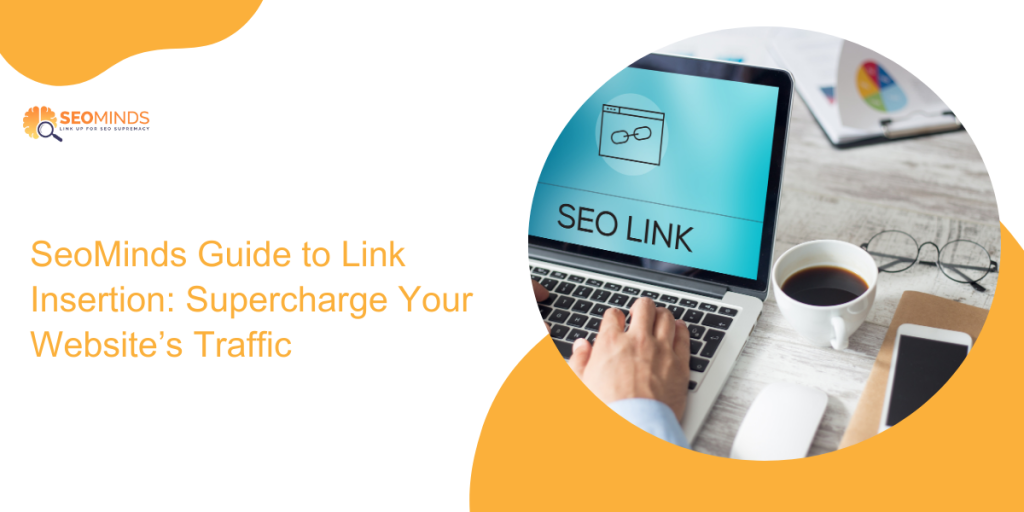SeoMinds’ Guide to Link Insertion: Supercharge Your Website’s Traffic
6 min read
Have you ever wondered how some websites seem to effortlessly rise to the top of search engine results? A big part of their success lies in smart strategies like link insertion. At its core, link insertion involves adding hyperlinks to your content that lead to relevant, authoritative sources or pages within your own website. This not only enriches your content but also signals to search engines that your page is valuable and well-connected.
Why Link Insertion Matters
Imagine your website as a small island in a vast ocean. Link insertion is like building bridges to other islands (websites), making it easier for visitors to travel to and from your site. These bridges help search engines understand your content’s relevance and authority, boosting your site’s ranking and driving more organic traffic.
Types of Link Insertion
Internal Links: These are links that connect different pages within your own website. They help visitors navigate your site more easily and keep them engaged longer.
External Links: These links lead to pages on other websites. When you link to high-quality, authoritative sources, it enhances your content’s credibility and can improve your SEO.
Backlinks: These are links from other websites pointing to your content. Backlinks are incredibly valuable for SEO because they signal to search engines that other sites consider your content worthwhile.
The SEO Benefits of Link Insertion
Improved Search Engine Rankings: Search engines like Google use links to discover new content and to determine the authority of a page. Quality links can significantly boost your ranking.
Increased Organic Traffic: By ranking higher in search results, your website becomes more visible to potential visitors, leading to increased organic traffic.
Enhanced User Experience: Well-placed links can make your content more informative and easier to navigate, improving the overall user experience.
Higher Credibility and Authority: Linking to reputable sources can make your content more trustworthy, and earning backlinks from high-authority sites boosts your own site’s credibility.
How to Identify Prime Link Insertion Opportunities
Identifying the right opportunities for link insertion is crucial for maximizing its benefits. Look for:
Relevant Content: Ensure the links you insert are directly related to the topic of your content. Irrelevant links can confuse readers and hurt your SEO.
Authoritative Sources: Link to reputable, high-authority websites to boost your content’s credibility.
High-Traffic Pages: Inserting links into pages that already receive a lot of traffic can drive more visitors to your linked content.
Crafting High-Quality Content for Link Insertion
Quality content is the backbone of effective link insertion. Here’s how to ensure your content is link-worthy:
Provide Value: Create content that offers real value to your readers. This could be in the form of informative articles, how-to guides, or in-depth research.
Be Original: Unique, original content is more likely to attract links. Avoid duplicating existing content; instead, offer a fresh perspective or new information.
Use Engaging Formats: Mix up your content with different formats like videos, infographics, and interactive elements to keep readers engaged.
Building Relationships for Link Insertion
Link insertion isn’t just about placing links; it’s also about building relationships. Here’s how to do it:
Reach Out to Influencers: Connect with industry influencers and bloggers. If they find your content valuable, they might link to it or share it with their followers.
Participate in Communities: Engage in online communities and forums related to your niche. Share your knowledge and link to your content when it’s relevant and helpful.
Collaborate with Others: Partner with other websites or bloggers for guest posts or joint projects. This can open up new link insertion opportunities.
The Role of Anchor Text in Link Insertion
Anchor text is the clickable text in a hyperlink. It’s important for both user experience and SEO. Here’s how to use it effectively:
Be Descriptive: Use anchor text that accurately describes the content of the linked page. This helps users and search engines understand what to expect.
Avoid Over-Optimization: While it’s important to include keywords, avoid stuffing anchor text with too many keywords as it can look spammy.
Keep It Natural: The anchor text should flow naturally within your content. Forced or awkwardly placed links can disrupt the reading experience.
Tools and Resources for Effective Link Insertion
Several tools can help you manage and optimize your link insertion strategy:
Ahrefs: A comprehensive SEO tool that helps you find link insertion opportunities and analyze your backlink profile.
SEMrush: Another powerful tool for SEO analysis, keyword research, and finding potential sites for link insertion.
Moz Link Explorer: This tool allows you to explore your link profile and find opportunities to improve your link insertion strategy.
BuzzStream: Helps you manage outreach and build relationships with influencers and other websites.
Common Mistakes to Avoid in Link Insertion
Even with the best intentions, it’s easy to make mistakes with link insertion. Here are some common pitfalls to avoid:
Overloading with Links: Too many links can overwhelm readers and dilute the value of your content. Be selective and strategic with your link placement.
Using Low-Quality Links: Links to low-quality or irrelevant sites can harm your SEO and credibility. Always link to reputable sources.
Ignoring Internal Links: Don’t focus solely on external links. Internal links are crucial for guiding visitors through your site and improving your SEO.
Measuring the Success of Your Link Insertion Strategy
To ensure your link insertion efforts are paying off, it’s important to track your progress. Key metrics to monitor include:
Traffic Increases: Monitor your website’s traffic to see if there’s an uptick following your link insertion efforts.
SEO Rankings: Use SEO tools to track your search engine rankings and see if they improve over time.
Engagement Metrics: Look at metrics like time on page, bounce rate, and click-through rates to gauge how engaging your content is.
Backlink Profile: Keep an eye on your backlink profile to see if you’re earning more backlinks as a result of your efforts.
Future Trends in Link Insertion
As digital marketing evolves, so does the practice of link insertion. Here are some trends to watch:
AI and Automation: Tools powered by artificial intelligence are making it easier to find link opportunities and automate outreach processes.
Voice Search Optimization: With the rise of voice search, optimizing your links and content for voice queries will become increasingly important.
Content Personalization: Personalized content that caters to individual user preferences is becoming more popular. Tailored link insertion can enhance user experience and engagement.
Conclusion
Link insertion is a powerful tool in the digital marketer’s arsenal. By understanding its importance, mastering the techniques, and avoiding common mistakes, you can significantly boost your website’s traffic and SEO performance. Remember, the key is to provide value, build relationships, and continually measure and refine your strategy.
Visit SeoMinds
FAQs
1. What is link insertion?
Link insertion involves adding hyperlinks to content that lead to relevant, authoritative sources or other pages within your own website to enhance its value and SEO.
2. How does link insertion benefit SEO?
Link insertion improves search engine rankings, increases organic traffic, enhances user experience, and boosts your site’s credibility and authority.
3. What are the different types of link insertion?
There are internal links (within your site), external links (to other websites), and backlinks (from other sites to yours).
4. What should I consider when choosing anchor text?
Anchor text should be descriptive, natural, and not overly optimized with keywords to ensure a good user experience and SEO benefit.
5. How can I measure the success of my link insertion strategy?
Track metrics such as website traffic, SEO rankings, engagement metrics, and your backlink profile to gauge the effectiveness of your link insertion efforts.





